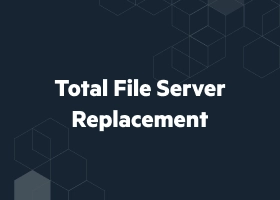Why & How to Replace FTP
What Can I Replace FTP With?
FTP, or file transfer protocol, was initially defined in 1971. While it is still widely used, with more than 21 million FTP servers connected to the internet today, many organizations are looking for FTP replacement solutions to transfer files over the internet. FTP became a commonly used approach for file transfers because it was deemed to be simple, efficient, and reliable. However, it has significant deficiencies related to security, speed, and data integrity, which are driving FTP replacements for file transfers.
For corporations and other entities that have daily requirements for file sharing, both within their organizations and among their third-party networks, there are a number of FTP replacement options that provide the requisite security, speed, and reliability. In addition, these solutions help organizations meet requirements related to compliance with various government and industry mandates, such as HIPAA, SOX, the GDPR, and PCI DSS. Following are the leading FTP replacement solutions.
- SFTP (SSH File Transfer Protocol)
- FTPS (File Transfer Protocol over SSL/TLS)
- AS2 (Applicability Statement 2)
- HTTPS (Hypertext Transfer Protocol Secure)
- MFT (Managed File Transfer)
- Secure cloud file sharing
Among the many reasons why these technologies, especially those offered as a cloud service, are used as an FTP replacement include the following.
Security
Corporate IT security policies can be used to manage file access and use to ensure that data protection protocols meet internal standards. An important capability for corporate IT security is traceability, which makes it possible to see who has accessed files. This is not available with FTP, which allows cybercriminals to hack into FTP servers and retrieve information without leaving a trace.
Ease-of-use
Users can easily map and sync files, which can then be accessed as though they were within a local drive. Most solutions provide an intuitive UI that enables users to share documents and collaborate with others in real-time, eliminating the need to send emails back and forth.
Ready access to files
Files can be accessed remotely from any location using different types of devices. And, users can sync files and access them offline.
Additional functionality provided by FTP replacement options include:
- Ability to create backups in case of data loss
- Better management of the data exchange environment, especially to meet the requirements of highly regulated industries
- Access to files available through a web browser or an application
- Auditing and reporting capabilities
- Automatic data replication
- Built-in encryption at-rest
- Guaranteed up-time*
- No software to install, configure and manage*
- Option to upload and share files from anywhere and opt to store these files offline
- Support for meeting corporate, government, and industry compliance requirements (e.g., California Consumer Privacy Act or CPRA, General Data Protection Regulation or GDPR, Sarbanes–Oxley Act or SOX, Payment Card Industry Data Security Standard or PCI DSS)
*With cloud-based service offerings

Why Is FTP No Longer Used?
Although many FTP servers are still connected to the internet, their use, especially by organizations, has diminished significantly and continues to fall precipitously. FTP is still a functional technology, but it sorely lacks the security and other capabilities that are required by most organizations.
There are many reasons for FTP replacement and why FTP is no longer used, including the following.
Slow file transfers
FTP is slow and inefficient compared to other file transfer options. A long path with heavy traffic toward the FTP server limits transfer speeds, creating delays if the FTP server is located remotely far away. Latency can also be caused if the FTP server is shared with other users. A particularly annoying scenario is when an FTP server lags due to too many users uploading files at once, and users can be blocked from accessing their files.
Unreliable file synchronization
The FTP protocol does not provide a way to synchronize the local and remote files. This means that, with FTP, it is not possible to automatically upload files from one directory on one server to another without manually initiating the process. FTP only allows users to upload files to the server, not pull files from it.
Vulnerable to sniffing and other attacks
FTP reveals too much information about what file is being transferred and who is transferring it. This is because the protocol does not include a way to encrypt the connection between the client and server. Since the files are left in plain text, FTP traffic is inherently vulnerable to packet sniffing and other attacks. Cybercriminals can intercept FTP traffic and gain access to the files as well as usernames and passwords using a standard protocol analyzer.
Weak authentication
The FTP protocol uses a simple user-password scheme to authenticate users to the server. This weak authentication approach puts the files and directories on your server using the FTP protocol at risk if a user’s credentials are compromised. In this case, any files and data on the FTP server can be stolen, or unauthorized changes can be made.
Can Cloud Storage Replace Existing FTP Servers?
Yes, cloud storage is an excellent option to replace existing FTP servers. However, before starting the process of evaluating all of the different technologies that are available for FTP replacement, consider these five questions.
Five Considerations when Evaluating an FTP Replacement
1. How much data needs to be transferred?
2. What is the frequency of data transfers?
3. What are the sizes and types of files that are most commonly transferred?
4. Is the organization bound by compliance requirements?
5. Is security a requirement for file transfers? If so, at what level is security required?
Why Cloud Storage for FTP Replacement
Cloud storage offerings provide robust solutions for FTP replacement. Several reasons why many organizations select cloud storage for FTP replacement are the following.
Cost of infrastructure
IT infrastructure is expensive to purchase and maintain, requiring dedicated staff to be on call for troubleshooting and ongoing system support. Moving to cloud storage eliminates the burden of resource-intensive FTP infrastructure. Cloud storage solutions allow organizations to have a hand-off approach to the upkeep and maintenance of storage and file transfer systems while upgrading service and security quality. In addition, organizations that move to cloud storage see an uptick in productivity due to the ease of use that comes with cloud storage solutions.
Secure access to data and services
Remote access is a must-have capability for most organizations. While remote access is possible with FTP, the security risks prevent it from being a viable solution. FTP does not provide the level of security that is required to protect users’ identities and the data they transfer. Cloud storage offers a range of security features to meet the needs of individual users and large organizations. In addition to protecting connections and transfers, cloud storage solutions include adjacent capabilities to support security requirements, such as granular user roles and file permissions to control access, activity alerts, and auditing.
Bandwidth
FTP is a notorious bandwidth consumer. Many users uploading and downloading files, as well as synchronization, puts a tremendous strain on networks. It also creates latency that slows service for users, impacting productivity and driving user frustration. With cloud storage, files are hosted externally and do not impact bandwidth in the same way that FTP does.
FTP Alternative for Simple File Sharing
In many organizations, FTP continues to be used for file sharing, because it has been in place for a long time, people are used to it, and changing systems has not been a priority. However, FTP is being replaced at an increasingly rapid pace due to serious security issues and its overall inefficiency.
Many generations of FTP replacement options have come and gone. The file-sharing solutions that are currently available offer options to meet the requirements of any user or organization. Among the many FTP replacement alternatives are the following technologies.
SFTP (SSH File Transfer Protocol)
SFTP, often incorrectly described as secure-FTP rather than the correct SSH-FTP, allows organizations to move data over a secure shell (SSH) data stream. It provides far better security than FTP by creating an encrypted data stream between the client and server, meaning data sent between them is encoded. SFTP can be used through an FTP client or directly on the server using SFTP-specific applications.
A highlighted feature of SFTP is its ability to prevent unauthorized access to sensitive information, including passwords, while data is in transit. This is done by ensuring that connections between senders and receivers are secure by requiring the user to be authenticated via two-factor authentication.
In addition, SFTP uses a crypto key exchange between the client and server to identify each of them as an authorized party. A username and possibly in combination or as a replacement for a static password is also used. Another touted characteristic of SFTP is that it is platform-independent and firewall friendly, only requiring one port number to initiate a session and transfer information.
FTPS (File Transfer Protocol over SSL/TLS)
FTPS, known as FTP over SSL/TLS, is a secure FTP protocol that is built on top of the existing FTP protocol to enable internal and external file transfers. Rather than using SSH to create a secure connection between client and server for the transmission of files like SFTP, FTPS uses TLS/SSL encryption to achieve this connection. Like SFTP, the FTPS protocol can use a second factor of authentication for added security.
FTPS has two security modes, implicit and explicit:
1. Implicit FTPS, the stricter of the two security modes, requires the SSL connection to be created before any data transfer can begin. It uses port 990 and creates an SSL/TLS tunnel as soon as the client connects to the server. Because FTPS uses port 990 by default to encrypt FTP traffic between clients and servers, it is possible to use both SFTP and FTPS simultaneously on the same server.
2. Explicit FTPS is the standard for FTPS. Using the FTP port 21, explicit FTPS can be customized and configured to use SSL when authenticating and performing data transfer. With FTPS, the negotiation takes place between the sender and receiver to establish whether the information will be encrypted or unencrypted. FTPS can be used to set requirements that an encrypted connection is used for sharing sensitive files or credentials.
AS2 (Applicability Statement 2)
AS2, or Applicability Statement 2, is used to transfer Electronic Data Interchange (EDI) information over the internet in a secure way. To protect EDI information, it is wrapped in a secure TLS layer, encrypting before it is transferred from point to point over the internet. AS2 also uses digital certifications for authentication.
HTTPS (Hypertext Transfer Protocol Secure)
Although it is widely known as a secure protocol used to serve up web pages onto a web browser, HTTPS can also be used to transfer files. HTTPS encrypts inbound traffic using an SSL/TLS session to protect the traffic between source and destination and uses certificates for authentication. It is widely used by websites, browsers, servers, network devices, and other connected devices.
MFT (Managed File Transfer)
Managed file transfer, or MFT, is an overarching secure file transfer protocol that supports each of the secure FTP solution options listed above (i.e., SFTP, FTPS, AS2, HTTPS) to enable secure data transmissions among internal users and authorized third parties. This method includes an extensive list of security features that make it an ideal choice for meeting the stringent guidelines of many industry regulations.
With MFT, users are able to send and share files with encrypted document sharing. MFT also provides access to specific users and can be used to send files via email with unique links for each recipient to enhance security and enable tracking. Passwords can also be used to protect file transfers.
It’s Time to Say Goodbye to FTP
With so many secure alternatives to FTP, there is no excuse for delaying FTP replacement. Take time to evaluate your options and select the right FTP alternative. Be sure to consider the security requirements as well as take this opportunity to upgrade to a solution that can bring positive changes to your organization, such as improved productivity, better security, reduced risk, and cost savings. A good file-sharing solution will be an FTP replacement and a step forward for your organization.
Egnyte has experts ready to answer your questions. For more than a decade, Egnyte has helped more than 16,000 customers with millions of customers worldwide.
Last Updated: 6th March, 2023



